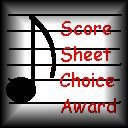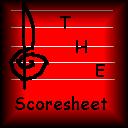STAR TREK: THE
MOTION PICTURE
20th Anniversary
Collectors' Edition
by Jerry Goldsmith
What can I say? This is probably one of the best film scores ever.
Goldsmith took his innovative approach to film scoring to the next level.
Although most remember this for the title march, I always think of the
perfect meld between the orchestra and electronics that the maestro achieves
in the V'Ger sequences. This special edition, although delayed for
five years, incorporates most of the score in a digitally remastered CD
complete with informative liner notes. Although the sound quality
is pinched in a couple of tracks, many instruments not able to be heard
in the previous mix are now present.
Track by Track Analysis:
1. Ilia's Theme (3:01)
Goldsmith begins the film with a concert suite
of the love theme. A great technique that he employs is the interpolation
of sections of the not-yet-heard main theme.
2. Main Title (1:23)
The famous main theme is introduced. As
the liner notes say, the snare drums were mixed down, which IMHO was a
poor choice. However, this arrangement has a very powerful introduction
that has not been heard in the subsequent films. The rest is played
as in the other films, although the brass are much more powerful.
3. Klingon Battle (5:27)
This lengthy set piece introduces the familiar
Klingon theme. Additionally, the large percussion instrument called
the Blaster Beam makes its first appearance, signifying the alien presence.
Also, "Klingon Battle" is basically the only action cue in the film.
It begins with an ominous piano note, and leads to the Klingon theme.
Eventually, a "busy" Federation motif appears, and the cue ends with
a climax of the Klingon theme.
4. Total Logic (3:44)
This previously unreleased track begins with
ceremonial drums interrupted by the Blaster Beam accompanied by electronics.
Spock's previously unheard motif makes its first appearance. Stravinsky-esque
electronics coupled with the Blaster Beam make a trasition to another statement
of Spock's Oriental-sounding theme, and this segues to my favorite statement
of the main theme. The brass chorale sounds simply marvelous.
5. Floating Office (1:03)
Another previously unreleased cue, this features
dreamy string and woodwind arpeggios over a statement of the main theme
in the minor mode. A great track.
6. The Enterprise (5:59)
This is Jerry Goldsmith's ultimate tour-de-force.
The main theme is put through numerous permutations, and as the characters
move closer to the ship, it becomes more and more grand. Finally,
when you think he can't possibly add any more, a giant pipe organ appears.
All of this climaxes in a smashing cadence. One of the reasons for
my opinion on the lack of the snare drums in the main title is that they
are very prominent here, and their appearance in the title would have provided
some nice continuity. Oh well....
7. Leaving Drydock (3:29)
"Leaving Drydock" plays as the Enterprise , um,
leaves drydock! It features more great brass playing of the main
theme, along with some weird electronics. At the end, Goldsmith adds
a tambourine to the main theme, and we move on to...
8. Spock's Arrival (1:58)
This previously unreleased tracks is one of the
coolest on the album. Spock's theme is played on electronics under
soaring clarinet and flute arpeggios. As the cue progresses, Jerry
adds some more weird percussion, and the arpeggios climax in some lush
harp chords. Spock's arrival onto the ship features some light, high-pitched
electronics.
9. The Cloud (4:58)
Goldsmith begins the film's seemingly-eternal
special effects sequences here with ominous arpeggios and pipe organ. The
rest of the track has many unusual electronic parts, including a reappearance
of the Blaster Beam. It also introduces and developes V'Ger's foreboding
low brass motif.
10. Vejur Flyover (4:57)
More Blaster Beam, electronics, and V'Ger music.
Goldsmith incorporates his avant garde techniques from Planet of the Apes,
although they are infinitely more listenable here.
11. The Force Field (5:03)
An extension of the previous two tracks.
This time, Jerry uses an ominous version of the Federation motif along
with V'Ger's theme. I think this is much more interesting and evocative
than the previous two cues, even though it is an inferior version from
the one heard in the film (the opening Blaster Beam is different, and the
electronic whale calls are much more pronounced in the film.)
12. Games (3:41)
Shimmering woodwind trills give in to a statement
of Ilia's theme. However, it is interrupted by the Blaster Beam and
an evocative version of V'Ger's motif. Ilia's theme appears once
again, only to be taken in by a huge brass crescendo. A bright two-note
ostinato appears as Spock knocks out a guard with a nerve pinch in order
to steal a space suit. A desperate statement of Ilia's theme ends
the track.
13. Spock Walk (4:19)
Even though it has a large number of weird electronic
effects, this remains my favorite cue on the album. The earlier V'Ger
material is worked into almost an action cue. Goldsmith contrasts
orchestral music meant to represent Spock with harsh electronics representing
V'Ger. Another huge brass crescendo leads into one of the most demented
passages I've ever heard. Soaring strings are met with a grinding
electronic noise. A large horn glissando coupled with pipe organ
combines with these to form a brutal climax. A statement of the Ferderation
motif ends the track.
14. Inner Workings (3:01)
This evocative cue is a reprise of the material
from tracks 9-11, except much faster. BTW, the beginning of this
was in the Star Trek: First Contact trailer.
15. Vejur Speaks (3:50)
Although still pretty good, this is probably
the weakest track on the album. Grinding ambience based on the Federation
motif forms the first 3 minutes, then Ilia's theme is stated for the last
time.
16. The Meld (3:09)
All of V'Ger's material climaxes in a track of
almost biblical proportions. At the end the main title march appears
for the first time since track 7. This is a highlight of the album.
17. A Good Start (2:26)
For the last scene of the film, Goldsmith employs
a reprise of the end of "The Enterprise." Unfortunately the sound
quality is muffled, and the performance is slightly underwhelming.
18. End Title (3:16)
Jerry introduces his standard formula for Trek
end titles (main theme/new theme/main theme). This time, Ilia's theme
is in the middle. I usually skip this, since all of this has been
heard before. Oh yeah, there's some bright electronic tones in the
first part of the main theme.
As I said above, it's a little hard to be unbiased,
since I think this is one of the best film scores of all time. Unfortunately,
instead of issuing the complete score on 2 CD's, someone at Columbia thought
it would be a good idea to rerelease a 1975 record with interviews with
the founder of Star Trek, Gene Roddenberry. Sure, it's okay the first
time, but after that, the second CD has no use (unless you want it as a
coaster for your coffee table.) So now, we still have about 40 minutes
of unreleased music, including spectacular alternate versions of "The Enterprise,"
"Spock's Arrival," "Leaving Drydock," and several other tracks. Oh,
well. If it weren't for the small sound quality complaints and that
second disc, this new release would be just about perfect.
Star Trek: The Motion Picture: The Final
Score
| Music Rating |
10/10 |
|
|
| Packaging/Liner Notes |
10/10 |
| Orchestral Performance |
10/10 |
| Sound Quality |
9/10 |
| Length |
7/10 |


| Reviews
by Title | Reviews
by Composer | Links
Page | ScoreSheet
Home |
Star Trek: The Motion Picture is Copyright 1998 by Columbia/Legacy.
Its appearance on this site is for informational, nonprofit use and is
not meant to infringe on copyright. This review is Copyright 1999
by Andrew Drannon. As always, these opinions are not those of Tripod
or anybody else.